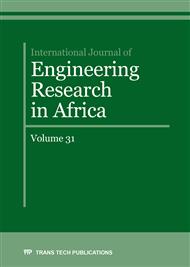[1]
L. Rui-Hua, Z. Jian-Fei, H. Bo and X. Guo-Qing, Adaptive inverse control of permanent magnet synchronous motor drive in a micro-electric vehicle, Proceedings of the Eighth International Conference on Machine Learning and Cybernetics, Baoding, 12-15 July 2009, p.1909.
DOI: 10.1109/icmlc.2009.5212190
Google Scholar
[2]
Z. Qianfan and L. Xiaofei, Permanent Magnetic Synchronous Motor and Drives Applied on a Mid-size Hybrid Electric Car, Vehicle Power and Propulsion Conference, 2008. VPPC'08. IEEE, Harbin, 3-5 Sept. 2008, p.1.
DOI: 10.1109/vppc.2008.4677807
Google Scholar
[3]
B. Skala, The Heat and Cooling of Electronically Switching Synchronous Machine as a Main Drive of a Car, International Conference on Applied Electronics, IEEE, 07-08 sept. 2011. Pilsen, Czech republic, (2011).
Google Scholar
[4]
S. Eiji, Permanent Magnet Synchronous Motor Drives for Hybrid Electric Vehicles, Transactions on electrical and electronic engineering, IEEJ Trans, 2007, No. 2, p.162–168, DOI: 10. 1002/tee. 20122.
DOI: 10.1002/tee.20122
Google Scholar
[5]
W. L. Soong and T. J. E. Miller, Field-weakening performance of brushless synchronous AC motor drives, IEE Proceedings - Electric Power Applications, Vol. 141, p.331–340, (1994).
DOI: 10.1049/ip-epa:19941470
Google Scholar
[6]
R. F. Schiferl and T. A. Lipo, Power capability of salient pole permanent magnet synchronous motor in variable speed drive applications, IEEE Trans. on Industrial Applications, No. 26, pp.115-123, (1990).
DOI: 10.1109/28.52682
Google Scholar
[7]
T. Sebastian and G. R. Slemon, Operating Limits of Inverter-Driven Permanent Magnet Motor Drives, IEEE Transactions on industry applications, Vol. 23, No. 2, pp.327-333, (1987).
DOI: 10.1109/tia.1987.4504909
Google Scholar
[8]
I. L. Osin, V. P. Kolesnikov and F. M. Yuferov, Permanent Magnet Synchronous Micromotors, (in Rusian), Moscow, Energia (1976).
Google Scholar
[9]
J. F. Gieras and M. Wing, Permanent Magnet Motor Technology, Design and Aplications, Marcel Dekker, Inc. 608 pp., New York, Basel (2002).
Google Scholar
[10]
P. Campbell, Permanent Magnet Materials and their Application, [Online], pp.158-203, ISBN: 9780511623073, Book DOI: http: /dx. doi. org/10. 1017/CBO9780511 623073.
Google Scholar
[11]
J. F. Gieras, Analytical approach to cogging torque calculation in PM brushless motors, IEEE International Electric Machines and Drives Conference, IEMDC'03., Vol. 2, pp.815-819, 2003, ISBN 0-7803-7817-2, DOI: 10. 1109/IEMDC. 2003. 1210329.
DOI: 10.1109/iemdc.2003.1210329
Google Scholar
[12]
E. Schmidt, M. Sušić and A. Eilenberger, Finite element analysis of an external rotor permanent magnet synchronous machine with star- and delta-connected tooth coil windings, XIX International Conference on Electrical Machines (ICEM), 6-8 Sept. 2010, Rome, ISBN 978-1-4244-4174-7, DOI: 10. 1109/ICELMACH. 2010. 5608233.
DOI: 10.1109/icelmach.2010.5608233
Google Scholar
[13]
R. Marko, Design of salient pole PM synchronous machines for a vehicle traction application – Analysis and Implementation, Lappeenranta, 157 p. Acta Universitatis Lappeenrantaensis 497 Diss. Lappeenranta University of Technology, (2012).
Google Scholar
[14]
A.M. El-Refaie, Fractional Slot Concentrated Windings Synchronous Permanent Magnet Machines: Opportunities and Challenges, IEEE Trans. on Industrial Electronics, Vol. 57, No. 1, January (2010).
DOI: 10.1109/tie.2009.2030211
Google Scholar
[15]
E. Schmidt and A. Eilenberger, Calculation of Position Dependent Inductances of a Permanent Magnet Synchronous Machine with an External Rotor by using Voltage Driven Finite Element Analyses. IEEE Trans. on Magnetics, Vol. 45, No. 3, March (2009).
DOI: 10.1109/tmag.2009.2012822
Google Scholar
[16]
J. Jin, The Finite Element Method in Electromagnetics, John Wiley & Sons, New York (USA), (2002).
Google Scholar
[17]
J. P. A. Bastos and N. Sadowski, Electromagnetic Modeling by Finite Element Methods, Marcel Dekker Ltd, New York (USA), (2003).
Google Scholar
[18]
Z.Q. Zhu and D. Howe, Influence of design parameters on cogging torque in permanent magnet machines, IEEE Trans. Energy Conversion, Vol. 15, No. 4, pp.407-412, (2000).
DOI: 10.1109/60.900501
Google Scholar
[19]
N. Bianchi and S. Bolognani, Design techniques for reducing the cogging torque in surface-mounted PM motors, IEEE Trans. Industry Applications, Vol. 38, No. 2, pp.1259-1265, (2002).
DOI: 10.1109/tia.2002.802989
Google Scholar
[20]
T. Tudorache and M. Modreanu, Design solutions for reducing the cogging torque of PMSM, Advances in Electrical and Computer Engineering, Vol. 13 (3), pp.59-64, (2013).
DOI: 10.4316/aece.2013.03010
Google Scholar


